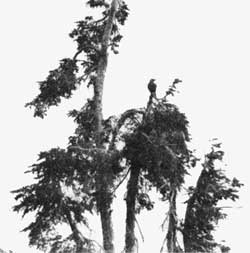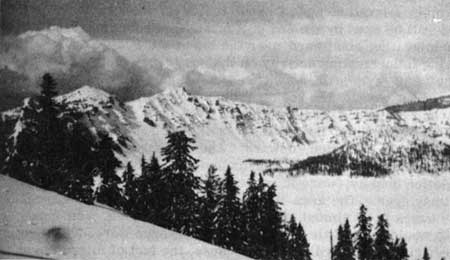Banding Crows and Jays
A banding program was begun in the summer of 1950 in order to understand better the behavior and movements of park crows and jays. Besides the standard, numbered, aluminum bands supplied by the U.S. Fish and Wildlife Service, most birds were marked with additional bands of several colors, so that each individual could be distinguished by his distinctive combination. This eliminated the necessity of retrapping for identification. To compare wear among the aluminum bands, a few birds were given two bands of this kind.
CANADA JAY, Perisoreus canadensis (Linnaeus)
Thirty Canada jays have been banded at our cabin at park headquarters and at Annie Spring during the past two summers. Of the twelve taken in 1950, one was banded at Annie Spring where it shared campers’ breakfasts and was most easily enticed by bread as bait. Two of the ten captured at our cabin had been banded previously by M. R. Mewalt in December, 1948. Colored bands were added to their standard bands for easy recognition. As our trap was set almost continuously, eight of the ten were taken more than once: five were retaken a second time, two were retrapped twice, and one individual was caught an additional four times. This is a different pattern from that of juvenile Steller jays that discovered the trap a very easy way to get food and were retrapped very frequently.
Of eighteen Canada jays captured in 1951, four were banded at Annie Spring Campground within an hour. Two of fourteen taken at our cabin had been banded in December, 1948 and were given the extra identifying bands. Six of the 1951 birds were retrapped; three were recaptured a second time; one was captured two additional times; the other two entered the trap three more times. Three banded in 1950 were retrapped in 1951, but only one of these had been retrapped in 1950. Apparently these three individuals had forgotten about the trap during the winter. Once retrapped in 1951, they remembered their lesson and did not enter the trap again. As soon as all of these jays that came to our feeding platform in 1951 had been banded, the trap was no longer set. Thus it is impossible to compare retrap figures for the two years.
The behavior of the Canada jays on the feeding platform in the presence of Steller jays is very interesting. The Canada jay is the smaller and less aggressive bird and does not eat or alight on the platform while the Steller jay is feeding. However, a change took place in this behavior at the end of the 1951 banding period. A number of juvenile Steller jays moved into the area the last week in August and began using the feeding platform regularly. By this time the Canada jays apparently had come to consider the platform their personal property, for they did not show the newcomers the usual respect. In fact, while they do not actually drive their competitors away, they do come and eat at the same time, and frequently when two or three of them arrive simultaneously the Steller jay is forced to leave.
A further problem in competition was added by the ability of one golden-mantled ground squirrel to jump from the ground onto the feeding platform. Other squirrels try it with most amusing results as they fail, sometimes by as much as eight or ten inches, and land in most undignified positions. On August 30, 1951, following two days of snow and rain, the Canada jays were extremely eager for food. When I put some out and pounded the can against the metal food platform, a sound which they have learned to identify with a replenished supply of food, not only the jays appeared but also the squirrel. The latter leaped onto the platform and began eating. The jays were hungry; one after another they landed on the platform and, facing the squirrel, ate with him. Finally, with three jays on the platform, they rushed the squirrel as though a signal had been given, causing him to retreat in great haste.
STELLER JAY, Cyanocitta stelleri (Gmelin)
When the banding trap was set and baited in 1950, a family of Steller jays made use of it as one of their main sources of food a large portion of the time. There was a great deal of snow in June and even July that year. Our first two banded Steller jays were adults which we banded June 15 and which we saw frequently during the remainder of the summer. They often came to the feeding platform and tried to get food from the trap by putting in their heads, while refusing to step inside. On July 19 we banded the first of several juveniles which we eventually identified as belonging to this family group by establishing which juvenile was begging from which adult. Those young became our star boarders.
In all, we banded six adults and four juveniles at the cabin in 1950. Three of these were retrapped once, one was retrapped nine times, two were retrapped 15 times, and one was retrapped 24 times. On August 5, 1950, a juvenile which had been banded on July 19, 1950, was retrapped five times in one day. All of the juveniles became so accustomed to the trap and to the procedure for release that when they heard the back door slam, a sign that someone was coming to release them, they ate with greater speed in order to get as much food as possible. When I came within a foot of the trap they stopped eating and started clinging to the wire sides of the cage farthest from the door. When I actually had my hand in the cage they made a few feeble flaps of their wings, much as a juvenile does to attract the attention of the parent bird when it wishes to be fed. They took as a matter of course the reading of the band number before release and made not the slightest effort to escape.
In 1951 we banded two adults and nine juveniles. Only one of these was retrapped and none of the birds banded in 1950 was retrapped. However, we do have 1951 sight records for two of the birds banded in 1950.
CLARK NUTCRACKER, Nucifraga columbiana (Wilson)
For reasons not yet fully understood, 1950 was a year in which Clark nutcrackers flocked to the rim area at the head of the lake trail and from there to the lodge in very large numbers. On the first morning that banding was attempted, the trap was set up in the vicinity of the wall not far from the Information Building and to the west of the walk to Sinnott Memorial. In one hour and a quarter, ten nutcrackers were banded. But when half an hour passed without further birds, a better location was sought and found beneath some dead trees at the head of the lake trail. For the rest of the summer, all banding at the Rim was carried on at that spot and an average of one bird per five minutes was maintained.
One hundred and sixty five nutcrackers were banded in 1950; one of these was banded at Annie Spring Campground, 5 at the cabin at park headquarters, and 159 at the rim. One of these birds had been previously banded with a wire ring which gave no information except that the bird had been seen during the winter of 1948-1949.
The sight records showed some very interesting things about the birds. There were eight birds among those we had banded that regularly went to Annie Spring Campground for breakfast. We first became aware of this when we encountered an “educated” nutcracker at the campground. Foolishly, we had attempted to bait the trap with peanuts just as we did at the Rim, only to discover that the Annie Spring birds were avian “country bumpkins” who did not know how to eat peanuts. They took each peanut and after examining it several times broke it into many small pieces and spent ten minutes eating the peanut piece by piece.
They were much more interested in bread, bacon, potatoes, and butter. When we found one that was “sophisticated” enough to swallow peanuts whole, as it was done on the Rim, we had much less trouble in trapping him. He had obviously been corrupted by the birds on the Rim. Further observations showed that there were eight birds which appeared at Annie Spring for breakfast, that arrived at the Rim about 9:30 AM for their share of the peanuts to be obtained there.
Of the 159 birds banded on the Rim in 1950, 120 were seen again that year. Two not seen again in 1950 were seen in the following year. Nineteen were seen both years. Four of the five banded at our cabin were eventually seen at the Rim; three banded at the Rim were seen as far away as the Watchman and fourteen were retrapped. Two of these were retrapped a second time, but none was ever captured more than three times.
The most interesting record of all of the nutcrackers banded in 1950 came to us because a hunter read the band. This man had shot at an owl on Mount Adams, Washington, and although he missed it, had seen it drop something that it was carrying. He investigated and found out that it was one of the Clark nutcrackers that we had banded a month and a half previously (September 1, 1951) here in Crater Lake National Park.
The small baseball-minded member of our family spent part of his time during the summer pitching peanuts to the nutcrackers. When, toward the end of the summer, he reported that he had found a nutcracker that could catch peanuts, we were doubtful, but investigation proved that one of the banded birds could do just that. This nutcracker would stand about five feet away and point his bill directly at the individual holding the peanuts. A peanut tossed within several inches of his head was caught without difficulty. If the peanut were thrown so that he could not catch it he paid no further attention to it and allowed one of his less accomplished companions to scramble for it. We immediately started tossing peanuts to all the nutcrackers that were around but we never found another one which would catch them.
Banding in 1951 was a very different matter. There were days when it was impossible to see a single bird between the lodge and the head of the lake trail, although occasionally one could hear them even when they were not present along the Rim. The nutcrackers showed a considerable indifference to peanuts; very few of the birds even knew how to eat them. In all, we banded 36 nutcrackers in 1951, all of them in the Rim and Rim Campground area. We have sight records for exactly half of these. This remarkable decrease probably does not indicate a decrease in total nutcracker population in the park, but rather a wider and more even dispersal because of the abundance of natural food in terms of the excellent cone crop in several species of trees.



